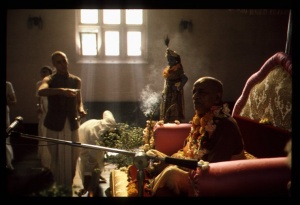CC Madhya 13.60 (1975)

A.C. Bhaktivedanta Swami Prabhupada
TEXT 60
- rājāra tuccha sevā dekhi' prabhura tuṣṭa mana
- sei ta' prasāde pāila 'rahasya-darśana'
SYNONYMS
rājāra—of the King; tuccha—insignificant, menial; sevā—service; dekhi'-seeing; prabhura—of Śrī Caitanya Mahāprabhu; tuṣṭa—satisfied; mana—mind; sei—that; ta'-indeed; prasāde—by mercy; pāila—got; rahasya-darśana—seeing of the mystery of the activities.
TRANSLATION
Śrī Caitanya Mahāprabhu was very satisfied to see the King accept the menial task of sweeping the street, and for this humility, the King received the mercy of Śrī Caitanya Mahāprabhu. He could therefore observe the mystery of Śrī Caitanya Mahāprabhu's activities.
PURPORT
The mystery of the Lord's activities is described by Śrīla Bhaktisiddhānta Sarasvatī Ṭhākura. Lord Jagannātha was astonished to see the transcendental dancing and chanting of Śrī Caitanya Mahāprabhu, and He stopped His car just to see the dancing. Lord Caitanya Mahāprabhu then danced in such a mystical way that He pleased Lord Jagannātha. The seer and the dancer were one and the same Supreme Person, but the Lord, being one and many at the same time, was exhibiting the variegatedness of His pastimes. This is the meaning behind His mysterious exhibition. By the mercy of Śrī Caitanya Mahāprabhu, the King could understand how both of Them were enjoying each other's activities. Another mysterious exhibition was Śrī Caitanya Mahāprabhu's simultaneous presence in seven groups. By the mercy of Śrī Caitanya Mahāprabhu, the King could understand that also.